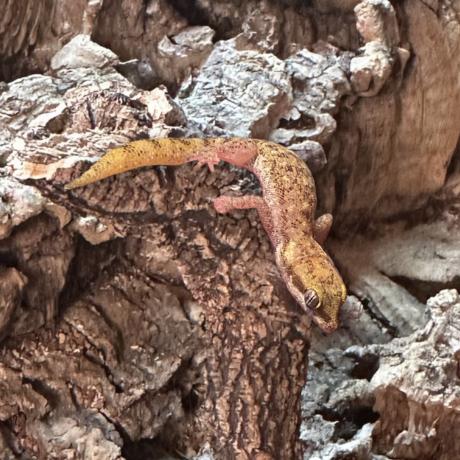

These tiny geckos are wonderful additions to any home. Though too delicate to handle, they are a fascinating, active species which do well in a small scale desert display enclosure.
A small sized lean bodied gecko, with adults normally reaching sizes of around no more than 7cm total length.
They have large lidless eyes with a darker band extending from the snout, through the eye and down towards their shoulders. They are a pale sand-yellow base colour, with pale brown and light coloured speckles on their bodies and a banded tail - the perfect camouflage against their native desert habitat. The tail serves as a defensive mechanism and can be dropped if the gecko is attacked by a predator, allowing the gecko time to run for cover. It will regrow but is often shorter and stubbier in appearance.
Unlike many other gecko species, Steudners Dwarf Geckos lack the ability to climb smooth surfaces and should be treated as terrestrial animals.
Sexing can be achieved once the animals reach a few months of age. Males are typically smaller than females, and develop a characteristic hemipenal bulge and femoral pores. These geckos are social and are often found in close proximity in the wild, this social nature means they are capable of communicating vocally, a small chirp can sometimes be heard when attracting a mate or establishing territory. When hunting, or communicating with other geckos they will often arch their backs and wave their tails.
In the wild these lizards are found in the rocky arid desert regions of North Africa, from Algeria to the Red Sea, and south towards Sudan.
Being terrestrial geckos (land dwelling), enclosures provided should be horizontal rather than vertical and with a minimum length of 45x45x30cm (18x18x12”) for a pair, increasing in size for multiples. Wooden vivariums or terrainiums work best for housing Steudners Dwarf Geckos due to their heat retaining property, though glass terrariums can be used if heated appropriately.
When setting up a vivarium for any reptile, you will need to create a thermal gradient, commonly this is referred to as the ‘hot end’ and ‘cool end’ of the enclosure. Steudners Dwarf Geckos are ectothermic and rely on their surroundings to maintain their body temperature. Creating a clear thermal gradient allows the gecko to move to the most favourable area in the vivarium so they can warm and absorb energy which enables them to digest food.
The overall ambient temperature of the enclosure should be around 26°C, with a basking (hot end) temperature of 35°C. This can be achieved easily using a good quality thermostat connected to a basking spot lamp. An overall night-time temperature of around 21°C is advisable, so usually turning all lighting off at night mimics the natural nighttime temperature drop they would experience in the wild as the sun sets. If room temperature is too low, a ceramic heat bulb can be used on a thermostat.
It is important to provide your dwarf geckos with UVB light within the Ferguson range of zone 1. After all, they are crepuscular and whilst limited, they would have some natural exposure to the sun in the wild. Providing 12 hours of UVB light will also help simulate a natural daylight cycle and will aid calcium absorption via access to natural D3.
As Steudners Dwarf Geckos are from arid, desert environments, a relatively dry enclosure must be provided. However, a damp area is beneficial to aid geckos shedding their skin. Sphagnum moss in an enclosed cave works well. Provide a suitably sized water bowl on the cool end of the enclosure for drinking.
Ensure you fill out the enclosure well, to provide plenty of coverage so that your gecko feels secure. For cage décor, we suggest recreating a piece of desert for them. Provide reptile caves, cork bark for them to climb over or hide under, combined with live or artificial plants. Use a sand/soil based substrate to cover the floor of the enclosure and spot clean dropping using a sand scoop. As this species is too small and skittish to handle, an environment filled with enrichment will give them the best possible life.
Steudners Dwarf Geckos are insectivores. This makes feeding relatively simple as they eat an array of different suitably sized live food. Favourites are Fruit Flies and crickets. Baby or juvenile Steudners Dwarf Geckos should be fed daily on 5-10 insects of suitable size, adults should be fed every other day with as many insects as they will eat in one sitting.
Lastly and most importantly you must use a good quality dusting powder to provide essential calcium and vitamins to your Steudners Dwarf Gecko. The majority of reptiles and amphibians in captivity require additional calcium, vitamin and minerals to compensate for eating a less varied diet than their wild ancestors. The easiest method for coating your livefood is to put a little supplement powder in a zip-lock bag, add the insects and gently shake. Use some forceps to transfer the livefood into your enclosure. This way, you are not wasting your supplements and only dusting the insects needed per feed.